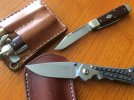One thing that got old for me even though I don't recall it actually effecting my knife buying habits was the market being driven by the latest thing they've convinced people they won't be able to live without.
It seems a lot of things many people find " necessary " about their modern folders are things the designers and manufacturers have simply convinced people they needed.
There's nothing wrong with conveniences and getting used to them, but I was able to be honest with myself in the fact that I didn't really need these conveniences that I had gotten used to.
They never stopped being convenient I just realized they weren't necessarily better or at all a real must for me and I'm perfectly fine with the time it takes to open a two handed traditional folder.
On occasion I have needed to finagle my knife open one handed but not often.
What most people don't realize, and this includes knife nuts, the whole modern knife thing is an artificially created phenomenon to stimulate market sales and continued sales. It has very very little to do with giving the end consumer a "better" knife, but to create a continuing market driven by the "next step up that you absolutely have to have."
Look back in time to a hundred years ago, or even two hundred years. What did the working cowboy pushing some ornery long horns up the trail to the railheads carry, or a freight wagon driver pulling a load of goods to the destination? Or some poor sailor working a square rigger around the horn to San Fransisco in the 1800's? Or even just a humble store clerck in a dry goods store?
They had single blade lock blades in the 1800's. When John Wilkes Booth was killed at Garrets barn in 1865, he had a folding dagger on him. Its on display at the Fords Theater museum in Washington D.C.. Its a nice one, with bone handles and a slim spear point blade. But the lock backs never were really popular with the working men. Not like the humble Barlow and other two blade jacks like the harness jacks, congress patterns. Or the cattle knife, or its genesis the premium stockman.
One hand opening? Most folks never gave it much thought because it was not an issue in working for living. If they did need a one hand knife, they had the original one hand knife; the sheath knife. It wasn't broken so it wasn't called a fixed blade back then like they are called now. Certainly some cowpoke dealing with half broke horses or branding wild cattle for a drive needed a good knife in his daily job description. But a simple jack seemed to do. Factory workers and shipping clerks the same.
The problem was after WW2, there was a great migration to the cities and better jobs. Returning GI's didn't want to back to daddies farm. Life in the cites and office jobs, warehouse jobs, delivery truck jobs, all changed the course of life in American. My own father was a prime example. He came from a working watermen family but he never returned to the eastern shore of Maryland. He moved to Washington D.C. for his new job and settled there. The new climate, the office cubicle, made a knife something not really needed anymore. By the 1970's a number of large U.S. knife companies were belly up with more following. The pocket knife market was dying. So, they came up with a new idea; promote the knife a thats part survival tool, and part tactical weapon in case of Russian paratroopers or the end of the world as we know it. The 1980's saw the birth of the tactical knife market. The sale of the knife as a ego driven fantasy cult worship object. A knife with certain features that were dubious in nature and questionable need. One company even showed their knife was capable of piercing a car door. Must have been some rogue Chevy's out there. I guess the office cubicle can be a dangerous place.
But, what do I know. I'm an old curmudgeon that doubts a lot of the new stuff. I guess in all those times I needed a knife, I somehow survived with a old fashioned pull it open slip joint. I must have been very lucky. I've been up on ladders and didn't need to one hand open a knife, in spite cutting painters tape. I've been out in the boonies lots of times, but never needed a folding knife strong enough to pry open a tank hatch. Heck, I've even been off to war in a hot jungle in Southeast Asia and got by with a regular pocket knife. If I absolutely needed something more, they gave us this pointy thing that fit on the end of our M16's called a bayonet. The supply room had lots of Camillus made TL-29's and 'demo' knives to hand out.
The so called conveniences they sell don't really mean much in the real world. Not compared to the convenience of having multiple blades available that have not only different edges, but different blade shapes for different jobs. Like the sheep foot of a stockman, or the screw driver tool on a scout knife. I tried a modern knife, once. Once was enough to experience the limitation of having just one blade that half the time was too big and awkward or doesn't have the most simple tool to improvise with.



